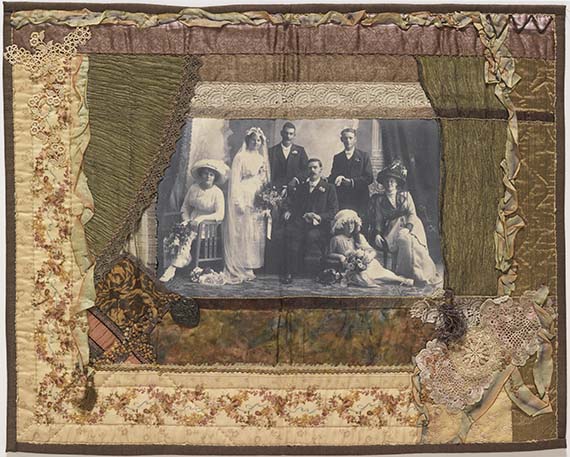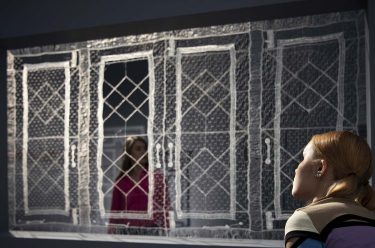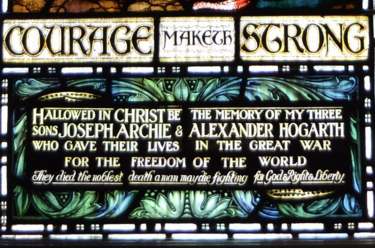
Since the 1970s, quilting and other traditional art forms have regained popularity in Australia. Complementing the ‘Quilts 1700–1945’ exhibition, the Gallery presents ‘Ruth Stoneley: A Stitch in Time’, a selection of textile works by this Queensland artist. Annette Brown writes on Stoneley’s exquisite memory quilt.
For visual arts practitioners of the late twentieth and early twenty-first centuries, the domestic has become a fertile area of creativity. Like their nineteenth-century counterparts, contemporary quilt-makers, such as Queensland’s Ruth Stoneley (1940–2007), who began quilting in 1979, have used this traditional craft form to recreate and examine aspects of the domestic world, both actually and figuratively.
Of the various forms of traditional crafts which have regained popularity in Australia since the 1970s, quilt-making — along with embroidery, lace-making, knitting and crochet — has become synonymous with the domestic and also possesses strong connotations of nostalgia. The ability of quilts to operate as cultural signifiers is also being reinforced and recreated in novels such as Alias Grace and films such as How to Make an American Quilt.(1,2) The memoryquilt format, in particular, has distinctive connections, both literally and metaphorically, with women’s domestic craft traditions spanning successive generations from the late nineteenth century onward.
Ruth Stoneley’s Untitled (memory quilt) c.2000s references the intimate lives of women through a process of recycling, reconstructing and decoration, and celebrates domesticity and the existence of both the maker and her family at a personal level. The process of quilt‑making was seen by Stoneley as a reflection of her own life, where ‘out of chaos and bits and pieces come whole objects that one puts together with love and care and integrity and somehow they get to work’.(3) Displaying an elaborately detailed surface, Stoneley’s memory quilt has become both a talisman and a souvenir, a repository for memories and storytelling, and, as author and academic Susan Stewart observes, ‘generates a narrative which reaches only “behind”, spiralling in a continually inward movement rather than outward toward the future’.(4)
With its random and asymmetrical construction, rich decoration of precious silk ribbons, lace, and metallic ‘charms’, and the central photographic image replacing an embroidered image, this memory quilt imitates the design principles of Victorian-era crazy patchwork. According to Stewart:
. . . the memory quilt, along with scrapbooks, photo albums and baby books can all be categorised as souvenirs of individual experience [and] are intimately mapped against the life history of an individual and tend to be found in connection with rites of passage.(5)
These include birth, death and marriage, and in the case of Stoneley’s example, marriage encapsulates, in Stewart’s words, ‘a transformation of status’.(6)
The limited colours of cream, pink, brown and antique gold attract the attention of the viewer in a subtle fashion. They are drawn to inspect the surface of the quilt at closer quarters, with a symbolic journey of contemplation and introspection undertaken through this delicate domestic space. Lace, ribbon and intimate family mementoes, including brooches, decorate the surface of the quilt, adding nostalgic resonance to the personal narrative of the maker. The focal point of the quilt, however, is the photographic image of a family wedding group. It is the pivotal point in a visual sense and also becomes a memento of the future family unit and the symbolic centre of the domestic space. As Stewart remarks, ‘the photograph as souvenir represents the preservation of an instant in time through a reduction of physical dimensions and a corresponding increase in significance supplied by means of narrative’.(7)
Like the crazy patchwork quilts of the Victorian era, Stoneley’s memory quilt recreates the domestic space on a contemporary and personal level. It has the capacity to create a sense of nostalgia in the viewer, revealing an intimate glimpse of the maker’s home life, generally hidden from the gaze of those outside the immediate family.
Dr Annette Brown is a textile historian and freelance museum consultant based in Wagga Wagga, New South Wales.
Untitled (memory quilt) is on display in ‘Ruth Stoneley: A Stitch in Time’ until 7 October 2013. An exhibition publication is available from the QAGOMA Store and online.
Endnotes
1 Margaret Atwood, Alias Grace, Doubleday, New York, 1996.
2 Jane Anderson (screenplay), Sarah Pillsbury and Midge Sanford (producers), How to Make an American Quilt, Universal Studios Inc., Los Angeles, 1995.
3 Quoted in Alan Moult, Craft in Australia, Reed, French’s Forest, 1984, p.112.
4 Susan Stewart, On Longing: Narratives of the Miniature, the Gigantic, the Souvenir, the Collection, Duke University Press, London, 1993, p.135.
5 Stewart, pp.138–39.
6 Stewart, p.138.
7 Stewart, p.138.



